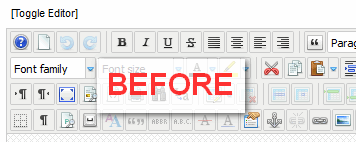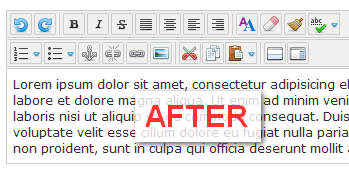Question: What annoys you the most when dealing with clients on Joomla Web projects? I’ll bet I know! Ideas provided in this article are intended to help reduce issues which sometimes arise between us and them (service provider and client) when dealing with website administration.
My own approach to working with clients has evolved over my eight years in the Web business and, more recently, has coalesced into a very precise methodology. These tips may or may not be appropriate for your particular situation, but I do hope they will at least provide you with a starting point for your own client-interaction process.
Less is More
Conventional wisdom suggests that more features mean more capability which, if we do the math, should result in a more useful product (such as our favorite CMS!). But most people are anxious when faced with a massive array of options and buttons in Joomla. However, most people get anxious when faced with a broad array of features and option buttons, such as that found in Joomla. Albert Einstein said it himself: “Everything should be made as simple as possible, but not simpler.”
As Web designers and Web developers, our perspective on website creation is distinctly different from that of our clients. In the spirit of keeping it simple, consider what elements are actually necessary to be enabled or displayed in the back-end, and what items we ought to disable or hide (such as menus, icons, options, modules, buttons) which we think nobody will use and would only complicate a non-techie’s experience with Joomla anyway. This approach allows users (Joomla managers and administrators) to focus on meeting their goals without distraction.
Use words that they understand
When discussing Joomla with clients, one of the biggest mistakes you can make is to start talking about modules, components, and plug-ins, and to throw around other webmaster’s terminology specific to Joomla (and certain other CMS products). Some clients may actually understand this stuff, but my experience suggests the majority of them do not and, frankly, it is not their job to understand it. That is our job. The client simply wants to have a website up with the possibility of self-editing after logging on. This is why my favorite approach to discussing Joomla with clients is to start with the concept of a homepage, contact page, subpages (articles), gallery, etc. The client’s job (or their copywriter’s) is to give you those individual pieces of content, including all related images, so that they may be placed into the CMS and the rules established for organizing them.
Remove what’s unnecessary
The most obvious way to simplify anything is to remove whatever is unnecessary. Take charge of the design and ensure you are only focusing on the delivery of features which add value. A significant change recently introduced in Joomla 2.5 (Joomla 3.0) is a new system to manage user permissions – the Access Control List (ACL). Currently, Joomla offers almost infinite control of what users and admins can see and do on a site. After installing Joomla, a series of user groups is already present, each with their own permissions applied. After completing the process of creating a website, it is a good idea to create a new group such as “client” – with access only to content considered essential for proper management of website content. The ACL Manager extension is a tool with which to set the basic ACL permissions for any component – even when the component doesn’t support the native Joomla ACL by default! This allows you to easily set custom back-end access to components for your users.
Another key concern of clients is the overloaded functionality displayed as toolbar icons in the JCE editor. Although we love the editor, it can be overwhelming to a regular user who simply wants to update an article. Furthermore, users can easily make such errors as pasting unnecessary tags or large images into their articles which can result in unexpected changes to the layout and appearance. To reduce such issues, you need only to configure the JCE profile, disable or remove unnecessary icons and switches, and add the ability to remove images, so that the client can focus on content, and not decay by clicking.
|
Figure 1 – Default view of editor form with JCE. |
Figure 2 – JCE editor form after removing duplicate and unnecessary icons and buttons. |
Figures 1 and 2. Default view of editor form with JCE on the left, and after removing duplicate and unnecessary icons & buttons (on the right).
To disable duplicate buttons from bottom change status of “Button – …” plug-ins. (By the way, I don’t know why but in JCE 2.2.4 I have problems with turning the Editor Toggle option off.)
Summary
Removing unnecessary and duplicate features, options and distractions from the Joomla administration (The Admin Interface) area will lighten the load on users so they can focus on getting their jobs done, and to have a more efficient experience. After all, the devil’s in the details!

